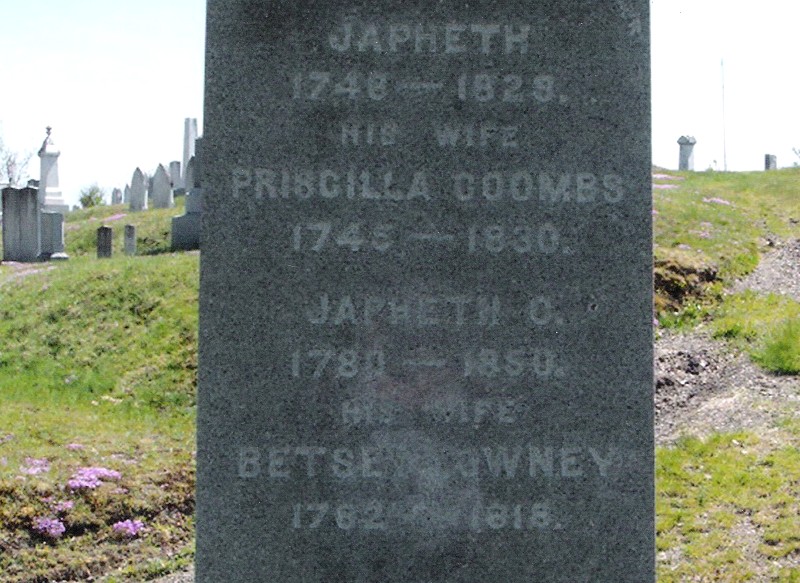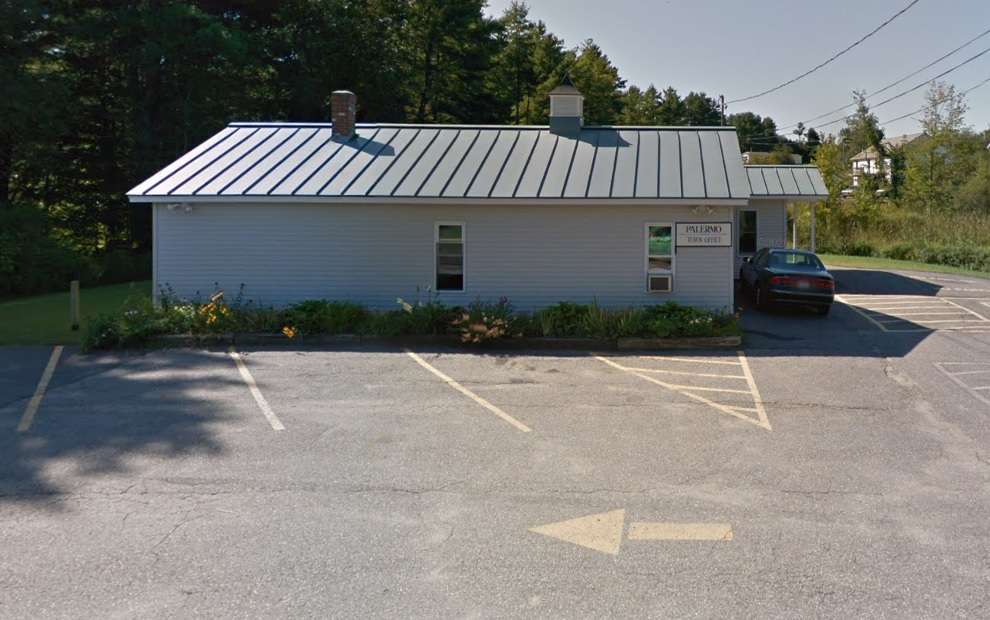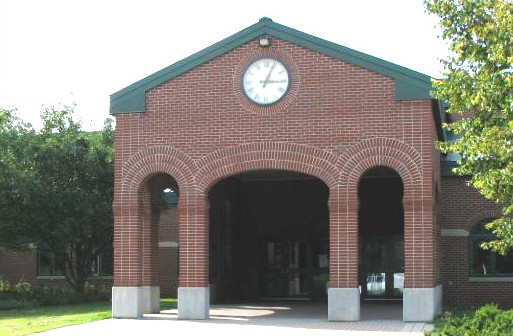
Japheth Washburn grave in China Village Cemetery
The Town of China had five high schools at various times in the 19th century. The one in China Village lasted into the 20th century; Erskine Academy in South China (next week’s topic) was founded in 1883 and is thriving in 2025.
Your writer summarized histories of these schools in a Sept. 23, 2021, article in this series. Much of the following is reprinted from that issue of “The Town Line,” with additions.
* * * * * *
The earliest high school was China Academy in China Village, in the north end of town, chartered by the Massachusetts legislature in June 1818. Charter language quoted in the China bicentennial history says the school’s purposes were to promote “piety, and virtue,” and to provide instruction “in such languages and in such of the liberal arts and sciences” as the trustees prescribed.
The school initially had five trustees, four China Village residents and Rev. Daniel Lovejoy, from Albion.
(Daniel Lovejoy, one of Albion’s earliest settlers, was the father of abolitionists Elijah Parish Lovejoy, killed by a mob in Alton, Illinois, on Nov. 7, 1837, and Owen Lovejoy, member of the house of Representatives from Illinois from 1857 until his death in March 1864. Elijah and Owen attended China Academy, and Elijah taught there in 1827, after he graduated from Waterville [later Colby] College.)
In 1819, the Academy charter was changed to allow 15 trustees.
The first China Academy building was on the shore of China Lake, in what is now Church Park, across from the China Baptist Church (built in 1814, relocated in 1822). John Brackett donated the land, “in consideration of the love and good will” he had for the trustees; the only condition was that they keep the fence around the lot in repair.
Henry Kingsbury, in his Kennebec County history, credited Japheth C. Washburn, a member of the Massachusetts legislature, with getting China Academy chartered. He added that Washburn “with his own hands felled and prepared for hewing the first stick of timber for the building” that the trustees approved.
The bicentennial history says classes began in or before September 1823. The first two principals were Colby graduates.
In 1825 the Maine legislature approved a land grant for China Academy; Kingsbury valued it at $10,000. In November 1829, the trustees sold the lot in what is now Carroll Plantation (on Route 6, in Penobscot County, east of Lincoln and Lee) for $3,400 (about 30 cents an acre, the bicentennial history says).
With legislative support and “an encouraging student enrollment,” the trustees put up what Kingsbury called a “new and spacious” two-story brick building on the east side of Main Street, in China Village. (Neither the bicentennial history nor the county history dates either the first or second Academy building.)
This building stood across from the Federal-style house, dating from around 1827, that has housed the Albert Church Brown Memorial Library since 1941. The first classes there were in November 1828, with 89 students, the bicentennial history says.
The trustees gave the wooden building by the lake to the Town of China, to be used as a district school.
From 1835 to 1844 China Academy did well, under “able and experienced” Principal Henry Paine. There were 221 students in 1835 and again in 1844, most from China but some from other Maine towns. Teachers, in addition to Paine, included a Colby senior, a Colby graduate and at least one woman, Sarah A. Shearman, in charge of “instruction in the ornamental branches.”
School was held for four 12-week terms, beginning “the first Mondays of March, June, September, and December.” The history quotes advertisements in the weekly China Orb newspaper that said quarterly tuition was $3 for basic English reading and writing; $4 for advanced English courses; and $5 for “Latin, Greek, and French.”
The Academy had no dormitory. The history says it (trustees, teachers or both?) helped students find nearby places to board, at rates ranging from $1.33 to $1.50 a week.
After Waterville Academy was chartered in 1842 and organized successfully by James Hanson (graduate of China Academy and Colby College, profiled in the Nov. 21, 2024, issue of “The Town Line”) and Paine left China in 1844, China Academy’s enrollment dropped. By 1850, average enrollment was around 50 students. The Civil War caused a temporary closure.
After the war, the Academy reopened and, the history says, in 1872, “had a staff of five who were teaching 40 to 60 students a term.” Terms were “shortened to ten weeks,” and tuition increased to $3.50 a term for basic English, $4.50 for advanced English and $5.50 for foreign languages or bookkeeping. Music was added, 20 lessons for $10; the history does not specify vocal, instrumental or both.
The history says that students’ records “included the number of words misspelled, the number of times tardy, and the number of days they were caught whispering in class.”
As previously mentioned, in 1873 the Maine legislature required towns to provide high schools. According to the bicentennial history, after 1880 amendments to the law China Academy apparently became a hybrid – the brick Academy building was used to teach free high school classes, but “This institution still called itself China Academy and was supervised by a board of trustees.”
Kingsbury wrote that the group he called “stockholders” “held their annual elections and meetings until 1887.”
Enrollment rose – “54 students in the spring of 1883, 70 in the fall of 1884, and 88 in the spring of 1885,” the history says. More girls than boys enrolled in each of those terms, after years when male students had been more numerous.
The history lists courses offered, in a “four-year course sequence” in 1884-85: “English, math, geography, history, bookkeeping, sciences, and philosophy,” plus Greek and Latin “if requested.” There were two or three terms a year, and financial support came from the local school district, other nearby China districts and one district in Albion.
In 1887 the brick building was deemed unsafe and was blown up, scattering fragments of brick onto adjoining properties. The trustees sold the lot to the local school district.
The history says that “Willis R. Ward built a wooden schoolhouse at a cost of $1,000 which served as both high school and elementary school from 1888 to 1909.”
In 1897, China voters appropriated no money for high schools. The history says China Village residents funded one anyway, with state aid. By 1899 village residents also relied on “contributions and subscriptions” to keep high school classes going.
Courses included “advanced English, mathematics,…science… and a five-student Latin class.”
The China Village free high school gradually lost students early in the 20th century and closed in 1908. Many students transferred to China’s other private high school, Erskine Academy.
The wooden building remained an elementary school until the consolidated China Elementary School opened in 1949. It was sold and became a two-story chicken house. The building was demolished in 1969 and replaced by a house.
A China Village high school was re-established from the fall of 1914 through the spring of 1916 – the bicentennial history gives no reason. Classes met in the second floor of a no-longer-existing wooden building (later the American Legion Hall) on the southeast corner of the intersection of Main Street, Neck Road.
* * * * * *
The China bicentennial history provides partial information on three other nineteenth-century China high schools, in Branch Mills Village, in South China Village and at Dirigo.
The earliest, the East China high school in Branch Mills, “was established about 1851 in a building constructed for that purpose by Mr. Barzillai Harrington.” The building was on the south side of the village main street, west of the bridge across the West Branch of the Sheepscot River. It appears as a large rectangle on the town map in the 1856 Maine atlas, labeled “B. H. Academy.”
In 1852, the history says, elementary classes met in “Mr. Harrington’s high school building” because the district schoolhouse was “in such poor condition.”
An 1856 advertisement for the school listed Claudius B. Grant as the principal for an 11-week term beginning Sept. 1. Tuition was $3 per term for basic English, $3.50 for advanced English and $4 for “languages,” unspecified.
The bicentennial history cites China town reports saying high school classes were provided in Branch Mills in 1857 for one term; in 1865 for one term, taught by Stephen A. Jones, of China; in 1882, for two terms, taught by Thomas W. Bridgham, of Palermo; and in 1883 for one term, taught by J. A. Jones. The writer found no evidence of continuous classes, and locations were not specified.
Though classes were listed in 1882 and 1883, the Branch Mills map in the 1879 Maine atlas identifies the building by a name, indicating it was a private home. The China history says the Academy building was sold in the 1880s. Kingsbury’s history says it was in 1892 the Good Templars Hall.
A footnote in the bicentennial history adds: “In 1894 the school committee recommended a term of high school at Branch Mills, but the town records provide no evidence that it was held.”
The high school in South China Village started in the 1860s and ran at least intermittently through the spring of 1881, according to the bicentennial history.
In 1865, former primary school teacher T. W. Bridgham taught a spring high school term. In 1877-78, A. W. Warren was teacher for a seven-week term. F. E. Jones taught 51 students in the fall of 1880. The next spring, J. E. Jones taught what was apparently the final term, “with the expenses being borne by three adjacent school districts.”
The writer of the bicentennial history found only a single reference to the high school at Dirigo (or Dirigo Corner), where Alder Park Road and Dirigo Road intersect what is now Route 3 (Belfast Road). In 1877 and 1878, the town report described two China free high schools, South China “and a 20-week term at Dirigo.”
Fred D. Jones was the teacher at Dirigo, “and the supervisor of schools commended the residents of this quite small school district for supporting so long a term.”
(Attentive readers will have noticed numerous teachers named Jones. They were probably related, at least distantly, and were probably members of the Society of Friends. The genealogical section of the China history has 25 pages of Joneses, several identified as teachers. One of them will receive more attention next week.)
Main sources
Grow, Mary M., China Maine Bicentennial History including 1984 revisions (1984)
Kingsbury, Henry D., ed., Illustrated History of Kennebec County Maine 1625-1892 (1892)
Websites, miscellaneous
 by Jeanne Marquis
by Jeanne Marquis








 National Blood Donor Month is a time to recognize and celebrate blood donors, and to remind people of the importance of donating blood. During National Blood Donor Month Northern Light Health would like to extend gratitude to those who have generously donated in the past, saving countless lives, and making a profound difference in our community.
National Blood Donor Month is a time to recognize and celebrate blood donors, and to remind people of the importance of donating blood. During National Blood Donor Month Northern Light Health would like to extend gratitude to those who have generously donated in the past, saving countless lives, and making a profound difference in our community.